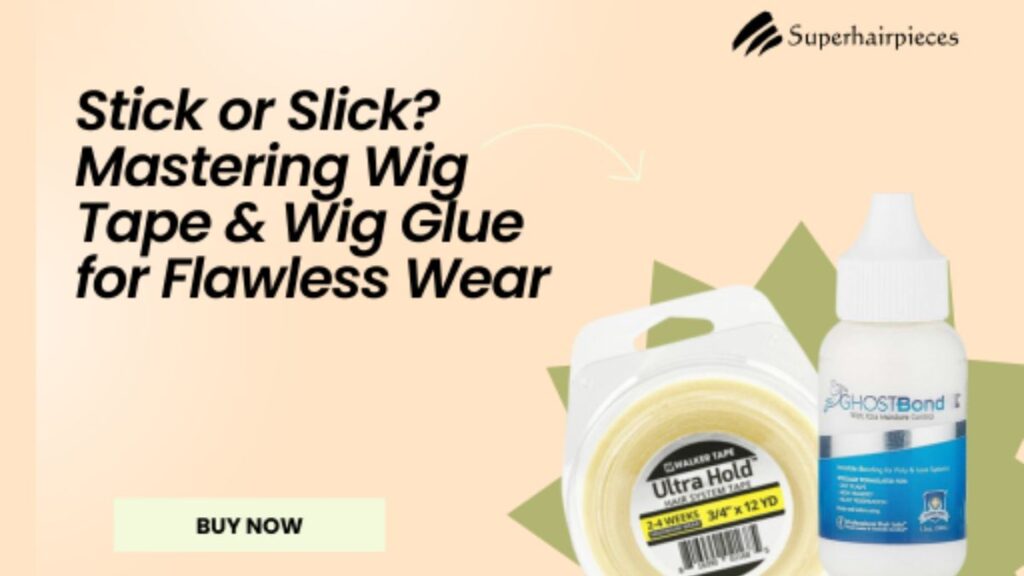Wigs are far more than just a beauty accessory; they are powerful tools of transformation, self-expression, and confidence. Whether worn for medical reasons, such as hair loss due to alopecia or chemotherapy, or simply to change your style without altering your natural hair, wigs offer unmatched versatility. However, achieving that seamless, natural look doesn’t just depend on the wig itself—it hinges on how well the wig is secured.
Two of the most widely used options for affixing wigs are wig tape and wig glue. Both have their distinct strengths and challenges. Whether you’re a daily wig wearer or someone who dons a unit for special occasions, understanding the nuances between these adhesives is key to achieving a flawless, long-lasting finish.
Let’s break down the differences between wig tape and wig glue, discuss their application methods, and explore the best tips and tricks for achieving the most secure and natural-looking results possible.
Understanding Wig Adhesives: Wig Tape vs. Wig Glue
At their core, both wig tape and wig glue serve the same purpose: they keep your wig securely in place throughout the day or even the week. But the way they achieve this goal and how they work with different skin types and lifestyles varies significantly.
Wig Tape: The Hassle-Free Hold
If you’re all about convenience, wig tape might be your best friend. Manufacturers create these sticky little strips from medical-grade adhesive. You can easily cut them or use them straight from the pack, and a quick press onto your wig and scalp secures the fit.
Advantages of Wig Tape:
- Quick and Simple Application: Wig tape is ideal for beginners. Simply peel off the backing and press the adhesive side onto the lace or wig base. No drying time is needed.
- Mess-Free: Unlike liquid adhesives, there’s no risk of glue spills or residue on your fingers.
- Adjustable Holding Strength: Wig tapes are available in various hold durations, ranging from daily wear options to extra-strong versions that last several days.
- Better for Sensitive Skin: Many wig wearers find wig tape to be gentler on the skin, especially when using hypoallergenic varieties.
- Minimal Cleanup: Removing wig tape is a breeze. Just peel off and use a bit of adhesive remover if any residue is left behind.
Disadvantages of Wig Tape:
- Not Suitable for Oily or Sweaty Skin: Adhesion may weaken if your scalp is oily or you’re engaging in intense physical activity.
- Requires Precision: Once stuck in place, it can be difficult to reposition the wig without reapplying the tape.
- May Not Last in Humidity: While suitable for short-term wear, tape may struggle to hold up in humid climates or during vigorous activities.
Wig Glue: The Long-Lasting Lock
Performers, athletes, and long-term wig wearers favour wig glue for its ultra-strong hold. It’s applied in liquid form and dries clear, providing a seamless look that’s particularly beneficial for lace-front wigs.
Advantages of Wig Glue:
- Superior Hold: Designed for long-term wear, some wig glues can keep a wig secure for over a week without reapplication.
- Sweat and Water Resistance: Manufacturers formulate many glues to withstand sweat, making them ideal for active individuals or those living in humid environments.
- Seamless Finish: Once dry, wig glue blends well with the scalp and provides a more undetectable finish.
- Ideal for Professional Styling: If you’re going for intricate styles or high-definition looks for photoshoots or events, glue offers unparalleled grip and security.
Disadvantages of Wig Glue:
- Longer Application Process: Applying glue requires careful layering and time for the adhesive to become tacky before securing the lace.
- Risk of Skin Irritation: Some glues contain strong chemicals that can cause allergic reactions or irritation if not patch-tested first.
- Difficult to Remove: Improper removal can damage both your scalp and the lace; therefore, using an appropriate adhesive remover is essential.
- Maintenance Required: Over time, glue residue can accumulate on the lace, necessitating thorough cleaning to preserve the integrity of the wig.
How to Choose: Wig Tape vs. Wig Glue?
Choosing the right adhesive depends on several factors, including your daily routine, skin condition, wig type, and the duration of wear.
- Daily Wear or Short Events: Wig tape is ideal for this purpose. It’s quick, easy, and perfect for switching styles frequently without much fuss.
- Extended Wear: Wig glue is ideal for multi-day wear, ensuring your wig stays firmly in place even during sleep or physical activity.
- Sensitive Skin: Tape tends to be milder on the skin than glue. Choosing hypoallergenic versions can help avoid irritation..
- Active Lifestyles: Glue wins here, especially with sweat-resistant formulas that withstand physical activity and heat.
- Beginner-Friendly: Wig tape is more forgiving for those new to wig application, as it eliminates the mess associated with glue.
Application Tips for a Flawless Finish
Mastering application techniques is just as important as choosing the right adhesive.
Wig Tape Application:
- Prep the Skin: Clean the application area with alcohol or a skin-safe cleanser to eliminate oils and sweat.
- Trim & Customize: Shape the tape to suit your wig’s design. Use ready-made strips for simplicity, or cut roll tape to fit as needed.
- Place Strategically: Apply tape to key areas such as the front hairline, sideburns, and nape for optimal hold.
- Press Firmly: Ensure each strip adheres well to the lace before placing the wig.
- Style to Conceal: Use edges or baby hairs to blend the lace and tape into your natural hairline.
Wig Glue Application:
- Cleanse Thoroughly: Start with a clean, dry scalp. Use an alcohol wipe or cleanser to remove any residue.
- Layer Wisely: Apply thin, even coats of glue. Let each layer dry until it becomes tacky before applying the next one.
- Tackiness Test: Don’t rush! Wait until the glue becomes slightly sticky to the touch—this is when it’s ready for use.
- Apply & Press: Gently align the lace and press it into place, smoothing outward from the center for an even finish.
- Set & Style: Allow a few minutes for the glue to fully dry before styling your hair.
Common Mistakes to Avoid
Even seasoned wig wearers can make mistakes that compromise the look and longevity of their wigs. Here’s what to steer clear of:
- Using Excess Glue – More Glue Doesn’t Mean a Better Hold. It just creates a mess and can affect lace durability.
- Skipping Skin Prep – Oils and sweat on the skin break down adhesives quickly.
- Not Testing Products – Always do a patch test with glue to ensure you don’t have an allergic reaction.
- Rough Removal – Tugging at your wig can cause damage to both the lace and your scalp. Always use a dedicated remover.
Final Verdict: Stick or Slick?
Both wig tape and wig glue have their place in the world of wig-wearing. The decision comes down to your lifestyle, needs, and preferences.
- Want convenience and flexibility? Stick with wig tape.
- Craving security and a flawless, long-lasting hold? Go slick with wig glue.
Remember, the right adhesive can make or break your wig experience. Don’t be afraid to experiment with different products until you find what works best for you. Ultimately, the goal is not just to wear a wig—it’s to wear it with confidence, comfort, and style.
And before you go, be sure to read through some of our other helpful posts!







